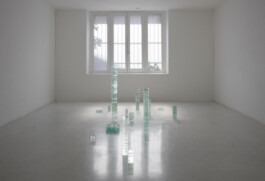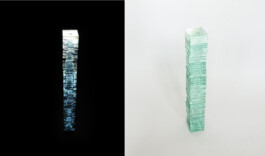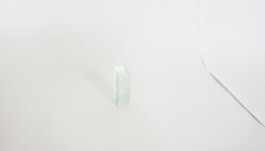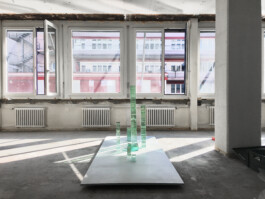Isolated Systems Vol.2, 2016 - ongoing
Glass, glue
Dimensions variable

Isolated Systems Volume 2 comprises individual towers – varying in height from 3 centimetres to over 1 metre – which the artist has erected with sheets of float glass stacked atop one another using drops of glue. Rather than producing a perfectly transparent sculpture – what Michel Foucault, referencing Bentham, might call an ‘omniscient’ and ‘panoptic’ space – Mathis chooses to play with variables of density, volume and orientation, exploiting the chromatic and intervallic principles of prismatic light. Depending on the thickness of the glass and the number of plates in contact with one another, the tower might simulate a mirror in which light from the vertical surfaces bounces in between the horizontal surfaces. Because of the vast difference in their sizes, the ideal position for viewing the intricacies of each tower shifts from standing above it to crouching to lying on the floor. At each tower’s centre, a distinctive vertical shaft appears in the negative space of the glue drop but vanishes at the slightest shift in the viewer’s perspective – an elusive riddle of hard and soft, visible and invisible at play at the heart of Mathis’ design.
Text by Erik Morse. Excerpt form Six Movements, Editions Piano Nobile, 2016




Isolated Systems Vol.2, 2016 - ongoing
Glass, glue
Dimensions variable
Isolated Systems Volume 2 comprises individual towers – varying in height from 3 centimetres to over 1 metre – which the artist has erected with sheets of float glass stacked atop one another using drops of glue. Rather than producing a perfectly transparent sculpture – what Michel Foucault, referencing Bentham, might call an ‘omniscient’ and ‘panoptic’ space – Mathis chooses to play with variables of density, volume and orientation, exploiting the chromatic and intervallic principles of prismatic light. Depending on the thickness of the glass and the number of plates in contact with one another, the tower might simulate a mirror in which light from the vertical surfaces bounces in between the horizontal surfaces. Because of the vast difference in their sizes, the ideal position for viewing the intricacies of each tower shifts from standing above it to crouching to lying on the floor. At each tower’s centre, a distinctive vertical shaft appears in the negative space of the glue drop but vanishes at the slightest shift in the viewer’s perspective – an elusive riddle of hard and soft, visible and invisible at play at the heart of Mathis’ design.
Text by Erik Morse. Excerpt form Six Movements, Editions Piano Nobile, 2016


